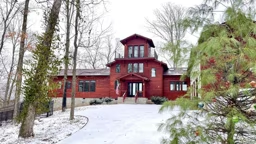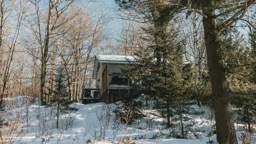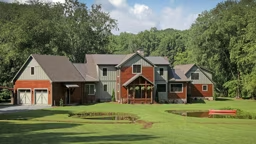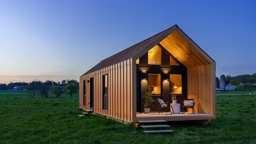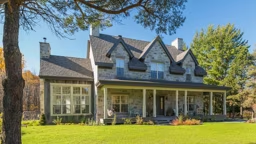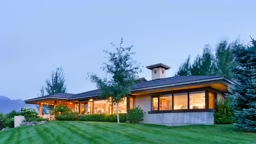The entire building process took three months from start to finish. “When we finished the floor and were able to look out over the pond – that was great,” recalls Greg. “It was very scenic and relaxing. Having a dirt-free place to sit and sleep was a really big deal.”
Little house on the pond
The Amundsons’ cozy little cabin consisted of a square 18x18-foot floor plan that they drew up themselves. The main room was large enough for a king-size bed, small table, and wood-burning fireplace. They doubled their living space by adding a porch and deck, each 180 square feet.
The kids slept in a loft, which lacked headroom, though they didn’t complain. They had all they needed with two mattresses on the floor and battery-powered tap lights for reading.
Plus, Greg rigged Coleman kerosene lanterns on a pulley system, which added a warm glow to the rustic atmosphere.
“It felt like we were living back in the days of Laura Ingalls Wilder,” says June.
Grilled burgers, hot dogs and brats were other mealtime staples, as was “Greg’s Speggs.” This culinary cabin tradition involved a dozen eggs, shredded cheese, and two cans of chopped up SPAM, all fried up in a cast-iron skillet. For June’s 50th birthday, the family indulged in fancier fare: prime rib and baked potatoes.
Outdoor fun
The Amundsons spent most of their time on the trails, in the ponds, on the porch, or by the bonfire. Greg and Erik hunted often. Family and friends zipped around on all-terrain vehicles (ATVs).
“I remember one time when Dana and her friends were 11 years old,” says June. “They went out on the ATVs after the spring melt and came back covered head to toe in mud.”
The Amundsons’ two black Labs, Josie and Sam, were also big fans of the wilderness experience. They spent the majority of their days frolicking in the ponds and fetching sticks of all sizes. “Sam brought us twigs,” recalls June. “Josie, on the other hand, would find these trees in the water that had fallen down and would paddle like mad trying to retrieve them.”
Fun & simple times
Without the distraction of TV and video games, the family embraced the simple life of playing cribbage, backgammon and rummy; roasting marshmallows around a giant bonfire; and – Greg’s favorite – taking the kids out during starry nights for snipe hunting.
“For those who may not know, snipes are soft, furry, mystical creatures,” explains Greg with a grin. “These nocturnal, elusive fur balls can only be stopped with a flashlight and captured with a pillowcase.”
Snipes notwithstanding, the Amundsons encountered their fair share of wildlife. Once, while on an ATV path, they came across a young black bear lumbering in the opposite direction. “We saw him, but he never saw us, which was probably for the best,” says Greg.
Other animals who frequent the property include coyotes, otters, eagles, ducks, geese, Sandhill Cranes and spring peeper frogs.
When the children were young, the Amundsons used the cabin all summer long. Over time, however, the family stopped going as much and, ultimately, sold the property in 2010.
Though they no longer own the place, the Amundsons treasure the memories they created, like the time Uncle Doug got stuck in the mud. Or the day when the kids and their cousins played for hours, not with Barbie dolls or LEGOs but with slippery, slimy leeches.
“The cabin brings family together,” says June. “I was so grateful that my dad made it there before he passed away. And my sister surprised me at the cabin on my 50th birthday.”
Just the sight of a full moon awakens great memories.
“When the moon was full, the beams shined across the pond and streamed into the cabin,” recalls Greg. “Coyotes were outside howling. The experience was surreal.”
Ever since reading Laura Ingalls Wilder’s memoir collection as a kid, Christy Heitger-Ewing has wanted to bunk on the floor of a wooden loft. Now that she’s, um, more mature, Christy still adores the idea, provided that a pillow-top mattress is part of the deal.
THERE'S MORE: To see a floor plan and bonus photos of the Amundson cabin, click here.
DESIGN RESOURCES
- Deer Creek Homes, Scandia, Minn., www.deercreek-homes.com
- Lindal Cedar Homes, Seattle, Wash., www.lindal.com
An off-the-grid cabin can be built for half the cost of a four-season place since owners don’t have to incur septic and well expenses. “If you build a basic, true off-the-grid cabin, that’s a great way to get a structure built on a property so that you may start enjoying it,” says Greg Amundson.
He says that inevitably, however, many owners consider wiring and plumbing the place for the future. The cost can snowball once you get into installing thermal window panes and insulation, etc. And if there’s truly no power grid available and owners must invest in solar, wind, and back-up generators, they ultimately spend more on their simple off-the-grid cabin than they would on a cabin on the grid.
PROS & CONS OF A WILDERNESS CABIN
Greg and June share their views of the pros and cons of owning an off-the-grid cabin:
The pros:
- Building an outhouse saves money. Greg learned that a septic system for his property would have cost around $18,000.
- A cozy fortress forces the family to forge memorable connections.
- “Yard” maintenance is minimal. Each spring, Greg would just mow and saw up fallen trees.
- It’s easy to enforce a no-electronics rule.
The cons:
- With limited refrigerator space, mealtime requires more planning. For instance, if you pack a salad with mayonnaise, that should be eaten on day one.
- Hauling your own water can get tiresome.
- There’s no bathing. The Amundsons used cleaning wipes for faces and had an 8-gallon jug of water for washing hands.
TIP: If you have an outhouse at your off-the-grid cabin, be sure to store toilet paper so mice don’t throw a chew party in your absence. “We learned that the hard way,” says June Amundson.
5 TIPS FOR BUILDING AND OWNING AN OFF-THE-GRID VACATION HOME
1. Keep it simple – “A square- or rectangular-shaped cabin with a lower pitched roof is easier to build than something irregularly shaped with a high roof,” says Greg Amundson.
2. Inviting nature – Sarah Nettleton, owner of Sarah Nettleton Architects in Minneapolis, Minn., suggests combining architecture with landscape design. “You can optimize energy efficiency and the beauties of each season by considering sun, wind, the change of seasons, topography, and soils,” says Nettleton, who authored the book “The Simple Home: The Luxury of Enough.” For example, study the wind direction to help you determine the best orientation of the building, and consider window placement in the building to maximize air flow and ventilation.
3. Aware & flexibile – Matt Finn, an architect who works with Nettleton, says people are used to just showing up and turning things on. With an off-grid cabin, however, you have to be aware of the amount of energy you have access to, especially if you rely on solar power. “If the forecast calls for mostly cloudy skies during the week you’re at the cabin, you’ll have to make adjustments,” says Finn. “Perhaps forgo the use of the hair dryer, the toaster, or some other energy draw to balance things out.”
4. Flooring – June Amundson suggests: Choose flooring that’s easy to clean. “We had a plywood floor that we painted and covered with throw rugs,” she says. “We used a shop vac several times a year to clean dirt and dried mud. The rest of the time we just used a Hoky Sweeper to pick up debris.”
5. Siting the outhouse – Pay attention to the location of the outhouse. Think about the path you’ll take to get there at night. “Light is a big deal when the generator isn’t running,” notes Greg. “Wall tap lights work great.”
Being a seasoned builder and dealer of Lindal Cedar Homes in Scandia, Minn., Greg knew he could erect a small rustic cabin in no time flat. The question was: Would his wife support the idea of building a wilderness retreat that lacked plumbing and electricity, on property that could only be reached by driving about 1,000 feet down a narrow dirt road, with the closest neighbor one mile away?
As it turns out, Greg swayed his wife with one simple sentence. “I told her that we could own our very own ‘On Golden Pond,’ ” Greg said.
Boom. She was sold.
June loved the idea of a simple nearby weekend getaway where they could take their two children, Erik and Dana, who were just the right ages to relish an adventure (13 and 10 years old at the time).
Building challenges
The limited property access and narrow, twisty driveway dictated the type of equipment that could be used for cabin construction. “We could not get any large equipment to the building site without having to build an access road, which would have been very expensive. So we decided on a post foundation system. By using a post foundation, we could use a smaller tractor with an auger to excavate the post holes,” Greg says.

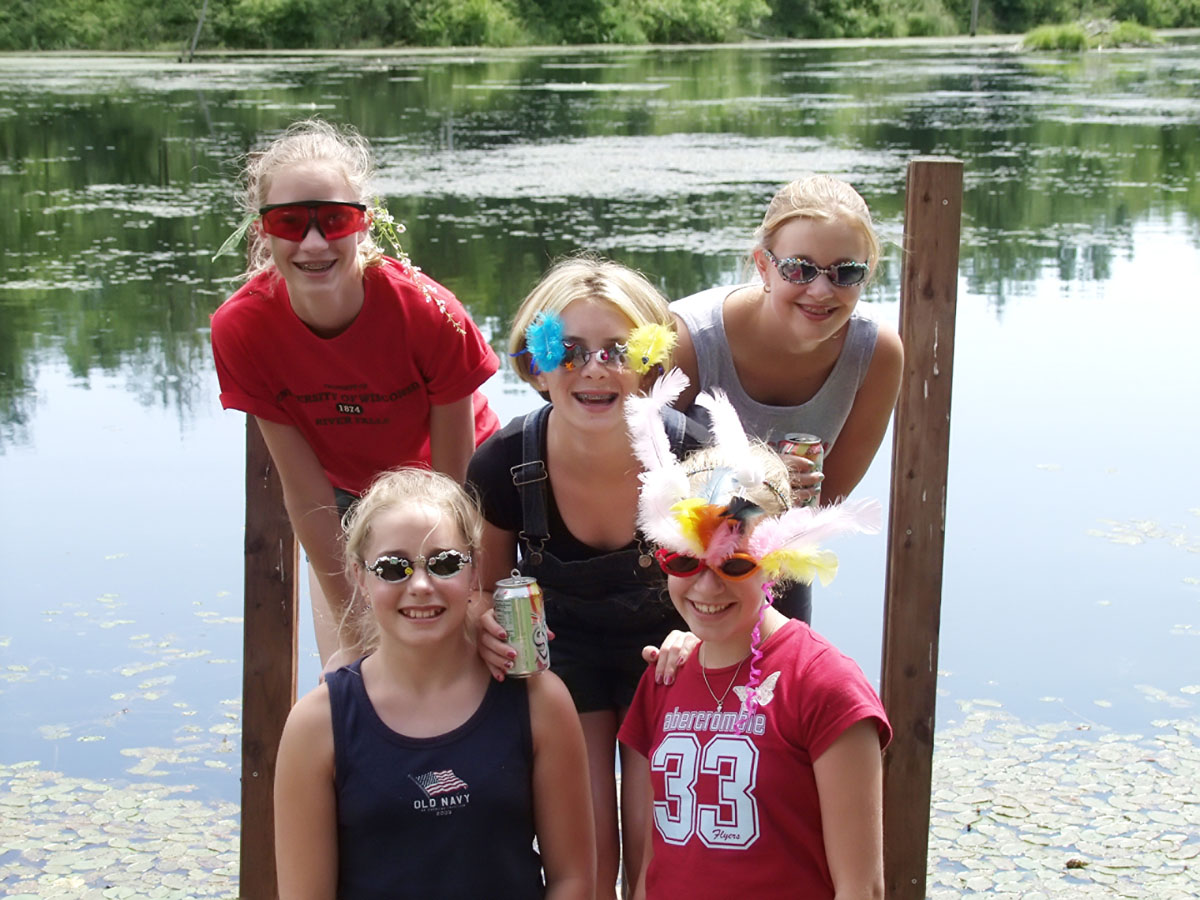





 Thinkstock.com
Thinkstock.com 



